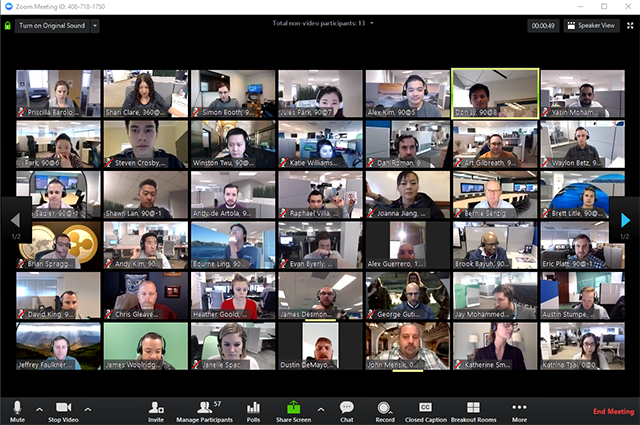How to organize efficient multilingual online meetings with simultaneous interpreters
Even in lockdown, international communication can be organized successfully.
Can multilingual meetings with simultaneaous interpreters take place online? Companies and organisations have started looking for alternative solutions since the COVID-19 pandemic has made physical meetings at traditional conference venues impossible.
However, even if borders have been closed, flights cancelled, and social distancing rules have been introduced in many countries, multilingual international relations in business and politics need not come to a standstill. Wherever online cooperation is possible, it can also happen in a multilingual setting, with the help of appropriately qualified simultaneous interpreters using the right equipment. Compared to a conventional conference, an online video conference can also bring significant savings by eliminating travel time and travel costs for all participants.
Sound quality is key
ISO standards for interpreting systems in conventional conference rooms require, among other things, a frequency band of 125 to 15,000 Hz so that the original sound reaches the interpreters as clearly as possible, in order to be correctly understood and translated. If interpreters do not have direct eye contact with the speakers and videoscreens must be used, specific regulations also apply to image transmission (1).
Audio and video quality standards have to be high because simultaneous interpreting requires extremely high concentration and causes severe stress (2).
During online events, sound and images are transmitted via the Internet. Therefore, even using state-of-the-art technical equipment, audio and video transmission to the interpreters will be worse than during traditional offline meetings where ISO-compliant interpreting equipment had been used.
The delay in transmission (latency) creates additional problems: a possible loss of information and an increase of cognitive load for the interpreters. If, on top of all these problems, an unstable internet connection and unsuitable hardware are used, sound and image transmission will be bad, thus making adequate interpretation impossible.
In order to minimize those disadvantages and still enable efficient communication during the event, all participants should be made aware of all the risk factors well in advance, in order to ensure that they have an adequately equipped workplace at their disposal.
5 basic rules for planning a multilingual online meeting with simultaneous interpreters:
-
- Use a wired connection instead of Wi-Fi
- Use a powerful PC or laptop in a soundproof environment
- Use a high-quality USB headset or a USB microphone, use a webcam
- Ask your interpreter for advice before choosing a platform, test it in advance
- Choose a qualified meeting host to effectively manage all conference settings.
Technical obstacles
The most common technical obstacles to efficient multilingual communication must be solved during the planning phase. Examples include participants using a slow or unstable Internet connection, Wi-Fi and unsuitable devices such as mobile phones and mobile phone accessories while working from home.
All participants must plan in time
Everyone who will give a presentation or ask for the floor during a multilingual online meeting should be in a soundproof environment with a fast and stable wired Internet connection. They should use a powerful laptop or PC with an ethernet cable (no WIFI, no tablets or phones) and a USB headset with a good microphone. They should use a webcam and adequate lighting so the interpreters can see them while they speak in front of the camera. It is important to pass this information on to all participants during the initial planning stage so that they can obtain the appropriate equipment for their home office or find themselves a different, adequate working space for the duration of the conference.
The current evolution of simultaneous platforms
Simultaneous interpreters can be connected to online meetings in various ways. There are some software platforms on the market that have been used in offline events to connect simultaneous interpreters working from different locations to the audio system at an event venue. Those so-called RSI-platforms (Remote Simultaneous Interpreting platforms) are now in the process of adapting to online conferences which have become more frequent since the introduction of social distancing measures. Most of them can now be linked to widely used web meeting and videoconferencing platforms. At the same time, some web meeting platforms have begun to incorporate a language interpretation function into their own software, thus allowing interpreters to supply simultaneous interpretation directly to online meetings.
These different platforms and their functionalities, prices and quality standards are continuously evolving. If you want to organize a multilingual online meeting it is very important to choose the right platform for each type of event. Not all of the currently available platform meet the necessary requirements for simultaneous translation. Your chosen platform should follow the requirements and recommendations of ISO/PAS 24019:2020: Simultaneous interpreting delivery platforms. Better consult a qualified conference interpreter before making your choice!
The International Association of Conference Interpreters (AIIC) recently prepared and published a set of guidelines for institutions and DI hubs using distance interpreting during the Covid-19 pandemic containing detailed recommendations and best practices which can be downloaded as a pdf file. For the full set of recommendations, please download AIIC Covid-19 Distance Interpreting Recommendations for Institutions and DI Hubs.
A competent host or moderator is an essential success factor
If you have implemented the above, then you have fulfilled some fundamentally important requirements for the success of your international online event.
However, having a competent host in place is key for a successful event. This is true for any kind of conference, but in online events it is critical. Your host or moderator should always make sure that only one microphone is switched on at a time. In a multi-language conference, it can also be important to announce the language of the next speaker in order to facilitate coordination between the interpreters, who are not sitting together in one booth but have to coordinate through a chat if necessary. In any case, it is important for the moderator to possess the necessary knowledge of platform used (prior training and practical tests are recommended) in order to be able at any time to coordinate all functions required for the meeting process. Another solution might be to have someone with the appropriate skills assisting the moderator. This is also useful if the contract with the respective platform includes technical support during the meeting.
A virtue made of necessity …
If the above mentioned 5 points regarding technical equipment are observed by all participants and when competent moderators and interpreters are involved, nothing stands in the way of an efficiently managed multilingual online event.
Hosts and participants will be surprised how pleasant and productive web conferences with simultaneous interpreting can be.
With the end of the pandemic, which we are all eagerly awaiting, this form of communication will certainly not disappear from the market.
On the contrary, once simultaneous functions are better integrated into currently available web conferencing solutions, international and multilingual meetings will probably become more and more frequent in order to save time and resources.
(1) DIN EN ISO 20109 “Simultaneous interpreting – Equipment – Requirements” and DIN EN ISO 20108 “Simultaneous interpretation – Quality and transmission of sound and image input – Requirements”
(2) http://www.tellerreport.com/news/–simultaneous-interpreter–the-third-most-demanding-profession-in-the-world-.BkAYa3YXN.html


